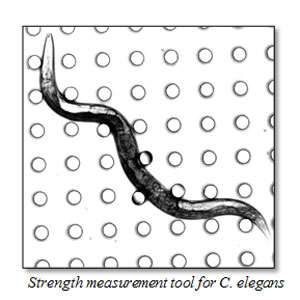Researchers to send worms into space for muscle mass and strength study

It is common knowledge that the longer humans spend in space, the longer it takes them to regain muscle strength upon their return to earth. The biggest question is, why. With the help of Caenorhabditis elegans, one Texas Tech University researcher hopes to find out.
C. elegans has been to space multiple times, and thanks to Siva Vanapalli, they will head to the International Space Station (ISS) soon in hopes of judging their durability in terms of muscular mass and strength.
The team of Vanapalli, an associate professor and graduate adviser in the Department of Chemical Engineering in Texas Tech University's Whitacre College of Engineering, Jerzy Blawzdziewicz, a professor in the Department of Mechanical Engineering, and muscle biologist Nathaniel Szewczyk from the University of Nottingham, recently received a grant from the National Aeronautics and Space Administration (NASA) totaling $326,879 for their study, "Determining Muscle Strength in Space-Flown Caenorhabditis elegans." The grant was one of 16 NASA awarded under two research announcements from its Human Research Program.
"What Dr. Szewczyk's previous work has shown is that muscle genes in C. elegans changed expression during their time in space," Vanapalli said. "However, nobody has actually measured if a change in the actual strength of the worms occurs. Our hypothesis is that, given that there are gene expression changes from previous studies, we also expect changes in force or strength in space."
Several factors, Vanapalli said, make the C. elegans the ideal animal upon which to conduct this study. The lifespan of a C.elegans is roughly three weeks, during which it lays about 300 eggs, making it a fast experimental animal model. The worm is transparent, allowing researchers to observe all of its parts.
Plus, the worm was the first animal whose genome was sequenced. C.elegans was found to have close to 18,000 genes whereas a human has roughly 22,000. Not only is the total number of genes in nematodes and humans comparable, but many of C. elegans genes are very similar to human genes, including many genes that control the growth of muscles.
"So if you do some experiments with this animal and you discover something, you are roughly half right," Vanapalli said.
Not only must Vanapalli and his research team prepare the worms for space travel, but they also developed a way to measure their strength. To that end, he and his students created small chambers that fit on a microscope slide that have tiny rubber pillars inside dangling from the top to just above the bottom.
As the worms move around this chamber, they push against the pillars. The strength of the worms is determined by how far the pillars are moved.
"It is similar to using Hooke's law for a spring," Vanapalli said. "If you know the extension of a spring you can figure out the force. It's the same idea for this where we treat the rubber pillars as an elastic spring, and based on the deflection observed on a microscope, we can determine the force applied."
While at the ISS, astronauts will insert these chambers with worms inside them under an optical microscope that Vanapalli and his students will control from the NASA laboratory in Cleveland. They will be able to observe and take pictures of the worms navigating through these pillars and measure how much the pillars are deflected by the worm's movement. They will then observe worms doing the same thing on Earth and compare the data from the two observations.
Having just received the grant earlier this month, Vanapalli and Blawzdziewicz and his students will spend the first six months of the two-year grant in a "flight definition phase" where they will ensure everything required during the experiment works as it should, from the rubber pillars to storage of the worms. The worms will be refrigerated for the flight into space and then returned to room temperature once in space.
Vanapalli said he hopes to begin the flight definition phase sometime in April with a goal of having everything ready for space by the fall of 2016. The worms will spend about nine weeks on the ISS, allowing researchers to study roughly six generations of the worms. Since the size of younger and older worms is different, the study will also enable measurement of strength in younger and older worms.
Vanapalli said future experiments will involve turning off certain genes in the worm, then testing each of those mutant worms to determine which gene best controls muscle mass and strength. This could help other researchers design drugs in the future that can synthesize the proteins leading to muscle growth or degradation.
The study also has important spin-off applications on Earth since decline in muscle strength leads to fall-related injuries, disability and loss of independence in elderly individuals, Vanapalli said. Blawzdziewicz added that observations of nematodes pushing against pillars will also help understand how neurons control muscle contractions, which may lead to addressing problems of neuromuscular degeneration involved, for example, in Parkinson's disease.
Provided by Texas Tech University



















